“Magical” is an effective adjective for a tourist leaflet. Used with the name of a city, it is vague enough to fit any place with family attractions, ethnic restaurants and playgrounds for children: a reassuring label, alluding to a Disneyesque kind of magic; that’s the cheap use of the word.
Beyond the touristic surface, some cities have deeper connections with secular and traditional magic; calling them “magical” may open forgotten (and far from reassuring) gates. What if a friend of mine would ask me to provide him some notes on the (truly) magical side of Venice? Here is a short list of ideas for an unusual tour in the Italian city – most of which you will never find on an official guide.
Forget about Matrix and its falling green digits: Tobia Ravà’s views of Venice are made up of numbers and Hebrew letters since 1971. Disciple of Umberto Eco, he obtained a degree in semiotics and is now involved in lectures, given in Universities and Superior Schools of Art, based upon his activity in the context of Hebraic culture, of mathematics logic and contemporary art. Elisabetta Donaggio hosts in her gallery “L’occhio” a number of his works. It is located in Dorsoduro 181/185 (See on the map).
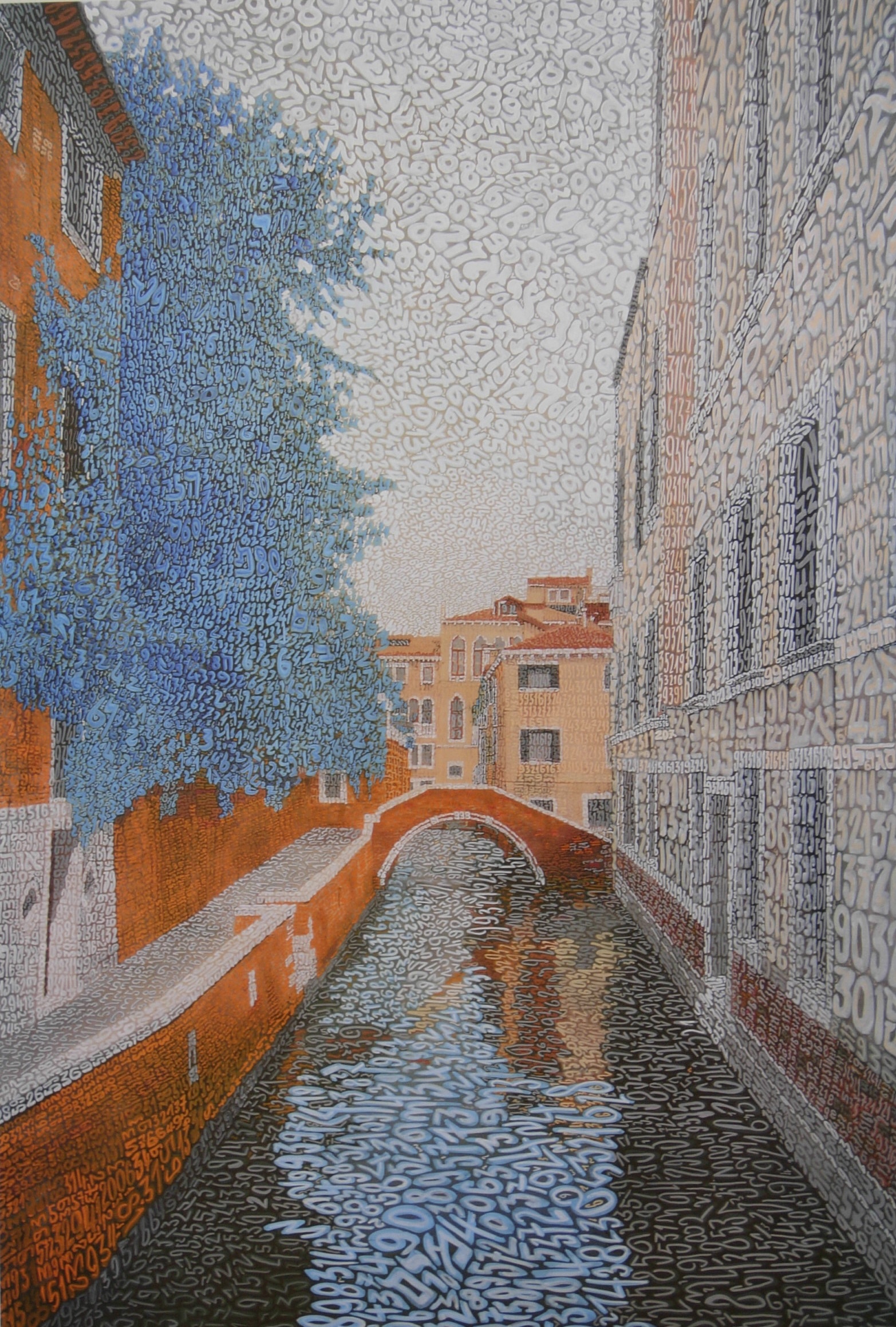
According to Henry Jones’ historical researches, three Knights of the First Crusade discovered the Holy Grail and guarded it in a Temple. When two of the them left for Europe, they left behind a marker that led to the Grail’s location in Alexandretta, today Iskenderun. In 1938 Indiana Jones found the mark on the tomb of one of the Knights, located into the Venetian catacombs; the entrance of the catacombs was hidden inside the church in Campo San Barnaba – but no, you will not find the big X marking the place where to dig, as seen in Indiana Jones and the Last Crusade (1989). The Church is located in Campo San Barnaba (See on the map).
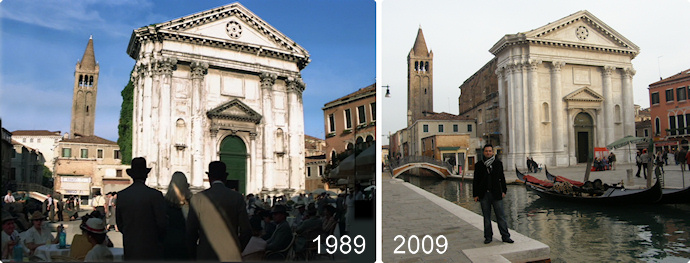
A screenshot from Indiana Jones and the Last Crusade (1989) – Me in Campo San Barnaba (2009).
If Venice is the city of masks, the uncanniest party involving them is the one portrayed in Eyes Wide Shut (1999). Stanley Kubrick bought them in the little shop Ca’ Macana, close to Campo San Barnaba (but check the website for finding their other showrooms in the city). The replicas of Bill Hartford’s mask are remarkably beautiful. Ca’ Macana is located in Dorsoduro 3172 (See on the map).
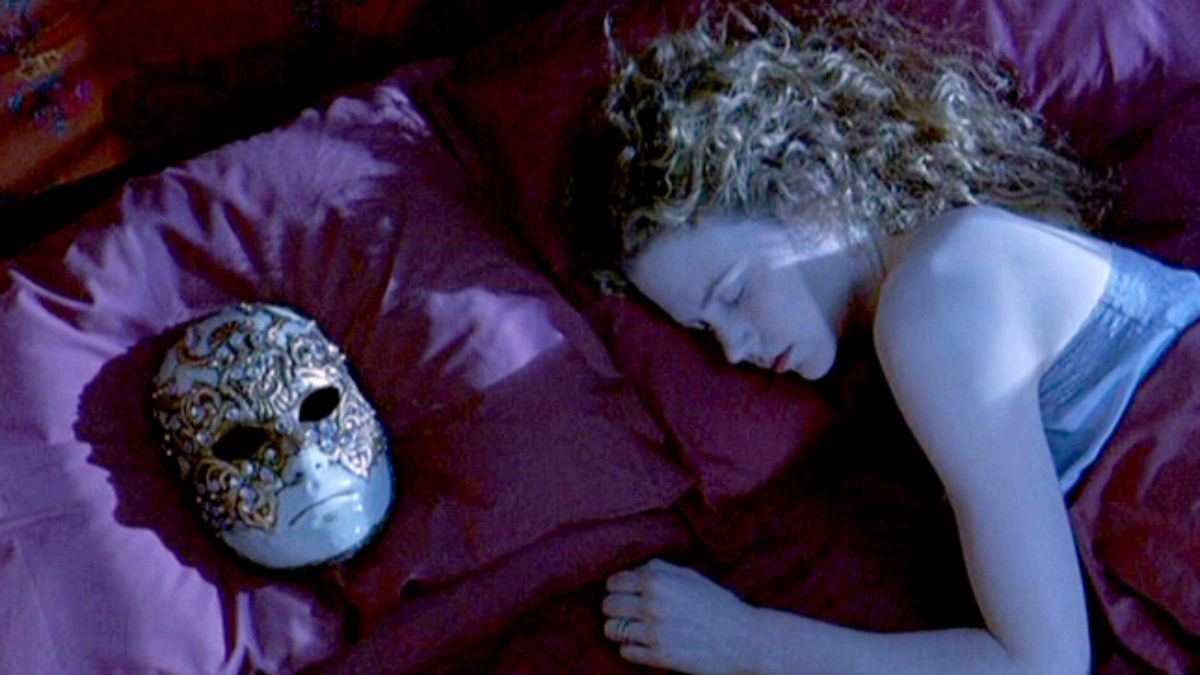
Uriah Fuller was the pen name used by Martin Gardner in two little books: Confessions of a Psychic (1975) and Further Confessions of a Psychic (1980). Written in first person as biographical memoirs, they employ a narrative style in order to better portray the wider context surrounding the supposed miracles of psychics. A classical book on tricks – based on the structure Effect/Material/Method – would not have been so effective: novels do provide a more complex environment on which the smallest subtleties of the art of deception can be staged with care by a good author; that’s something Henri Decremps knew well, when – with the goal of debunking Pinetti’s tricks – he invented the fictional character of Pilsener and set his 1784/5 books in a French colony in Africa. Written in the style of a novelist, the annex of White Magic Revealed and the complete Supplement to White Magic Revealed describe the reactions of Mister Hill before Pilsener’s miracles and the following confessions of the magician.
Venice was the background for one of the most interesting debunking novels of 18th century – Friedrich Schiller’s The Ghost-Seer.
Download it for free from my People’s Magic Library!
As a mathematician would put it,
Uriah Fuller : Uri Geller = Friedrich Schiller : Alessandro Cagliostro
The book is a first person account of a victim of Cagliostro’s deceptions, involving a lottery won by forcing a number, the Phantasmagoric projection of a ghost on the smoke of a lamp, stooges instructed to speak with a timing based on a clock, magnetic rings, thunders produces by electrical devices hidden in a cellar, social engineering to read minds – and even a crucifix used as an electric switch! The novel is cleverly balanced between enchantment and disenchantment, letting the reader perceive that strange mix of wonder and doubt which springs from the friction between Enlightment and Romanticism. The novel opens in piazza San Marco (See on the map), where the narrator meets a mystic pronouncing obscure words – whose character is based on Althotas, Cagliostro’s mentor. In the next chapters, during a card game in a inn in the same square, a brawl bursts between French and Italians; unfortunately there is no reference to carpsharpers...
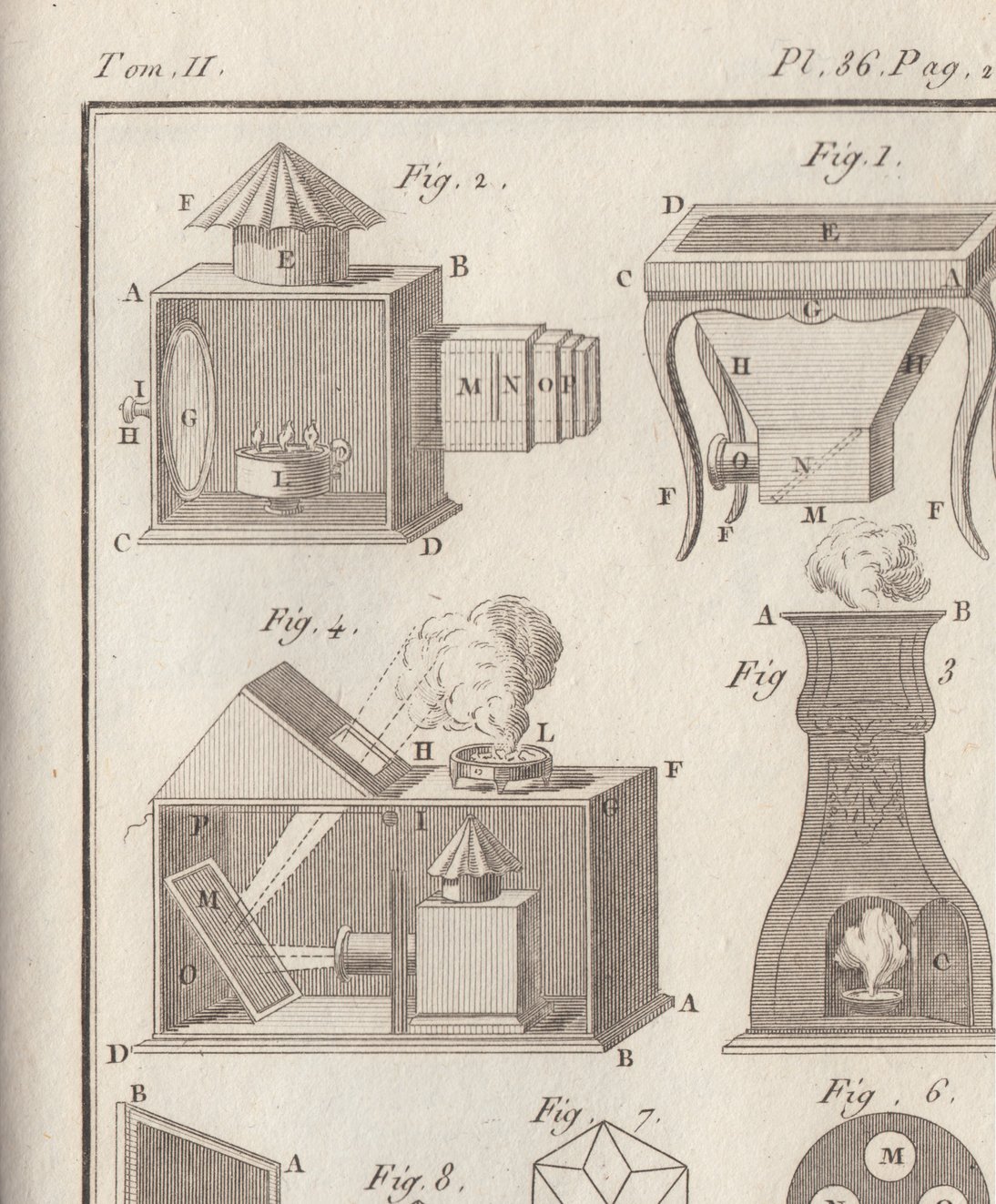
Figure 4: A lamp projecting ghosts on the smoke.
Table from Edmé-Gilles Guyot, Nouvelles récréations physiques et mathématiques, Paris 1799.
In piazza San Marco, the Doge’s palace hosts the prison called I piombi (“The leads”). In 1756, long before Houdini, Giacomo Casanova made a famous escape from it, publishing the story of the episode thirty years later. Soldier, spy, scoundrel, alchemist, gambler and writer, Casanova is probably the most famous trickster from Venice ever lived (being Harlequin just a fictional character.) His prison cell can still be visited and, if you are lucky enough, the guide will involve you in a catchy reconstruction of the rocambolesque episode.
The Ducal Palace is in piazza San Marco (See on the map).
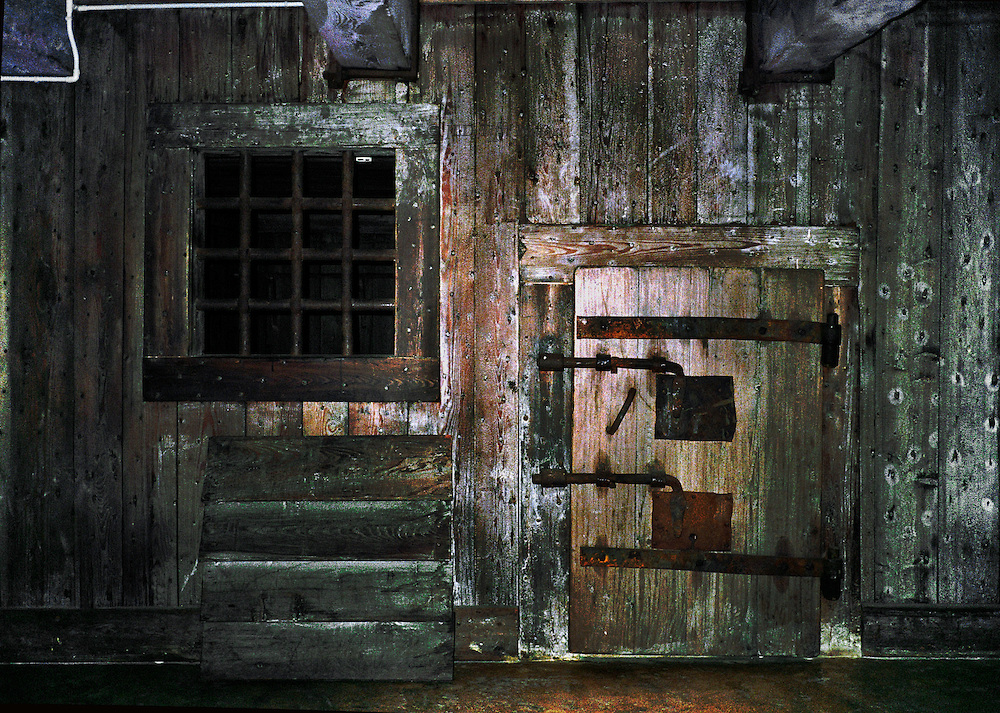
The door of Casanova’s prison cell
Francesco Rampazetto was a 16th century Venetian typographer foreseeing the Digital Age. He printed two of the most astounding books ever, both involving hypertexts four centuries before the World Wide Web. In 1565 Le risposte della signora Leonora Bianca (“The Answers of the Lady Leonora Bianca”) could be used as an oracular device based on the binary system like the Chinese I-Ching: the reader was led by Dante Alighieri and Beatrice to the darkest regions of Hell and the oracles were pronounced by demons. The book was overlooked by Roman Inquisition only because the author was a woman (see it on my Magic Books Exhibition Panel).
Download it for free from my People’s Magic Library!
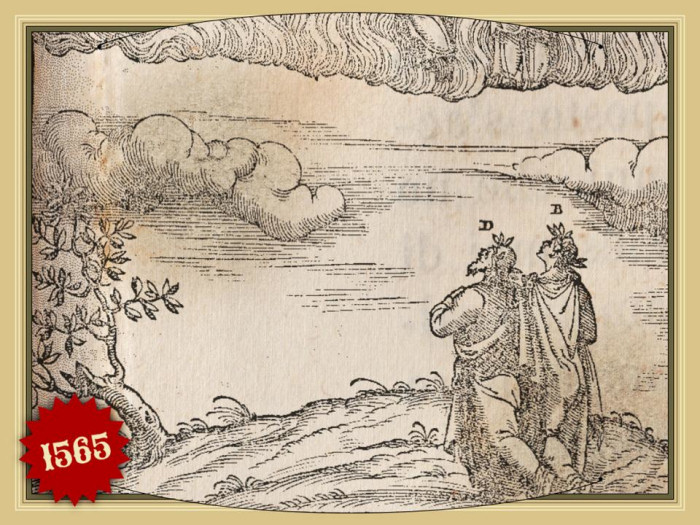
Dante and Beatrice on a page of the book (source).
In 1607 Rampazetto published a gimmicked book giving the reader the opportunity of reading thoughts in 17th century Italian courts: Andrea Ghisi’s Il laberinto (see it on my Magic Books Exhibition Panel, together with other two titles). Based on a complex mathematical structure (my analysis here), it still works and you can play with it thanks to my (philologically sound) Labyrinth emulator.
The Biblioteca Marciana in piazza San Marco helds a rich dossier on its author Andrea Ghisi, but the access is strictly reserved to professional historians.
Download it for free from my People’s Magic Library!
Rampazetto’s typography was located somewhere in calle delle Rasse, just behind the basilica of San Marco (See on the map.)
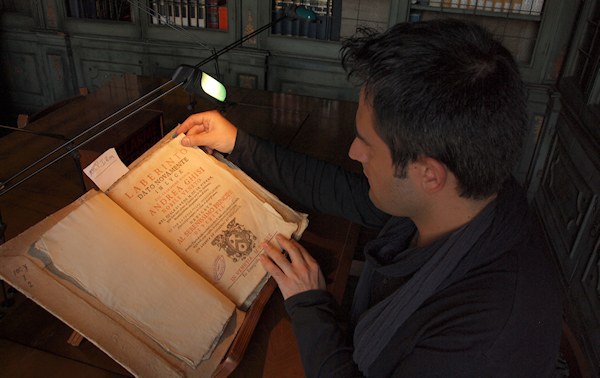
Me in the Queriniana library in Brescia with the 1616 edition of the book.
My friend Ivan Cenzi, curator of Bizzarro Bazar (by far the most interesting Italian blog on the uncanny, the bizarre, the macabre and the strange), suggested me to include the story of Marcello Pellegrino Ernetti (1925-1994), a Benedictine priest and exorcist who lived and worked in the Abbey of San Giorgio Maggiore in Venice. In the 1950s he claimed he constructed a time viewer as part of a group of scientists including Nobel Laureate Enrico Fermi. The “Chronovisor” – as he called it – could allegedly allow seeing and hearing events from the past. Interested in the history of theatrical performances, he claimed to have used it to witness a performance in Rome of the (now lost) tragedy “Thyestes” written by Quintus Ennius (169 BC).
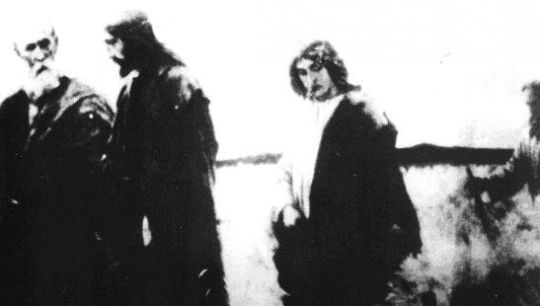
A photo of Jesus taken by Father Ernetti with his chronovisor
German writer Peter Krassa dedicated to this story his book Father Ernetti’s Chronovisor: The Creation and Disappearance of the World’s First Time Machine (US version: 2000).
San Giorgio Maggiore and its abbey is hosted on a small island (See on the map.)
What if I would found the Chronovisor? I would travel back to 1788, in order to see...
The celebrated Italian magician Giuseppe Pinetti performed in Venice from May 5th, 1788 (see here the announce on “News from the World”, 29 april 1788.) All available in Google Books, the Italian newspapers let Mauro Ballesio reconstruct all the dates of his seven shows: May 5, 8, 15, 20, 24, 25 and 26. A short review describes his dancing automata whose moves are indistinguishable from the ones of a real human being. The same article refers that the book by Henri Decremps debunking the show had been published in Italy (perfect timing!) but with no impact on Pinetti’s reputation.
The performances were held in Teatro San Luca now Carlo Goldoni (See on the map.)
More to come...
Thanks to Mauro Ballesio, Fabio Camilletti and Ivan Cenzi
BY-NC-SA 4.0 • Attribution-NonCommercial-ShareAlike 4.0 International